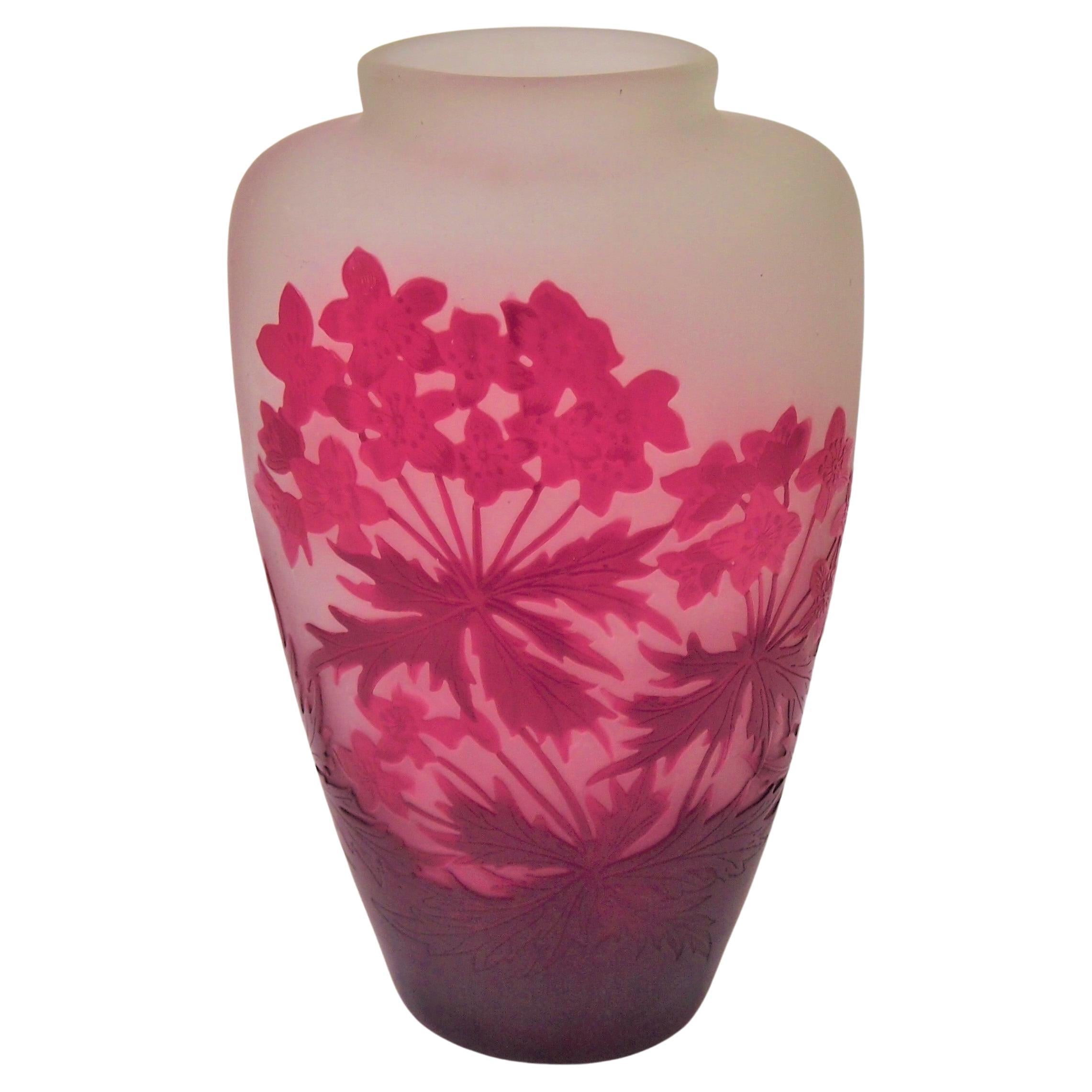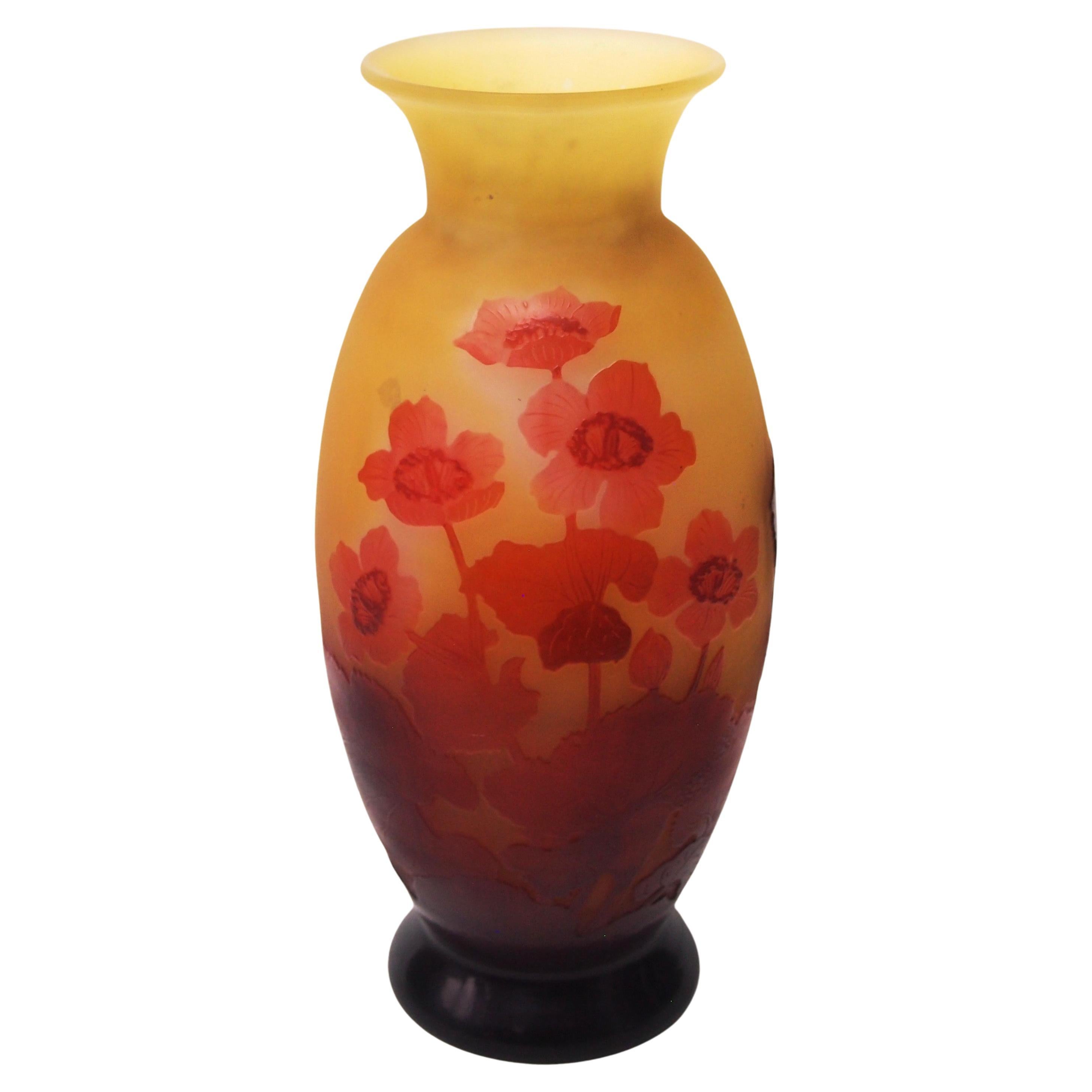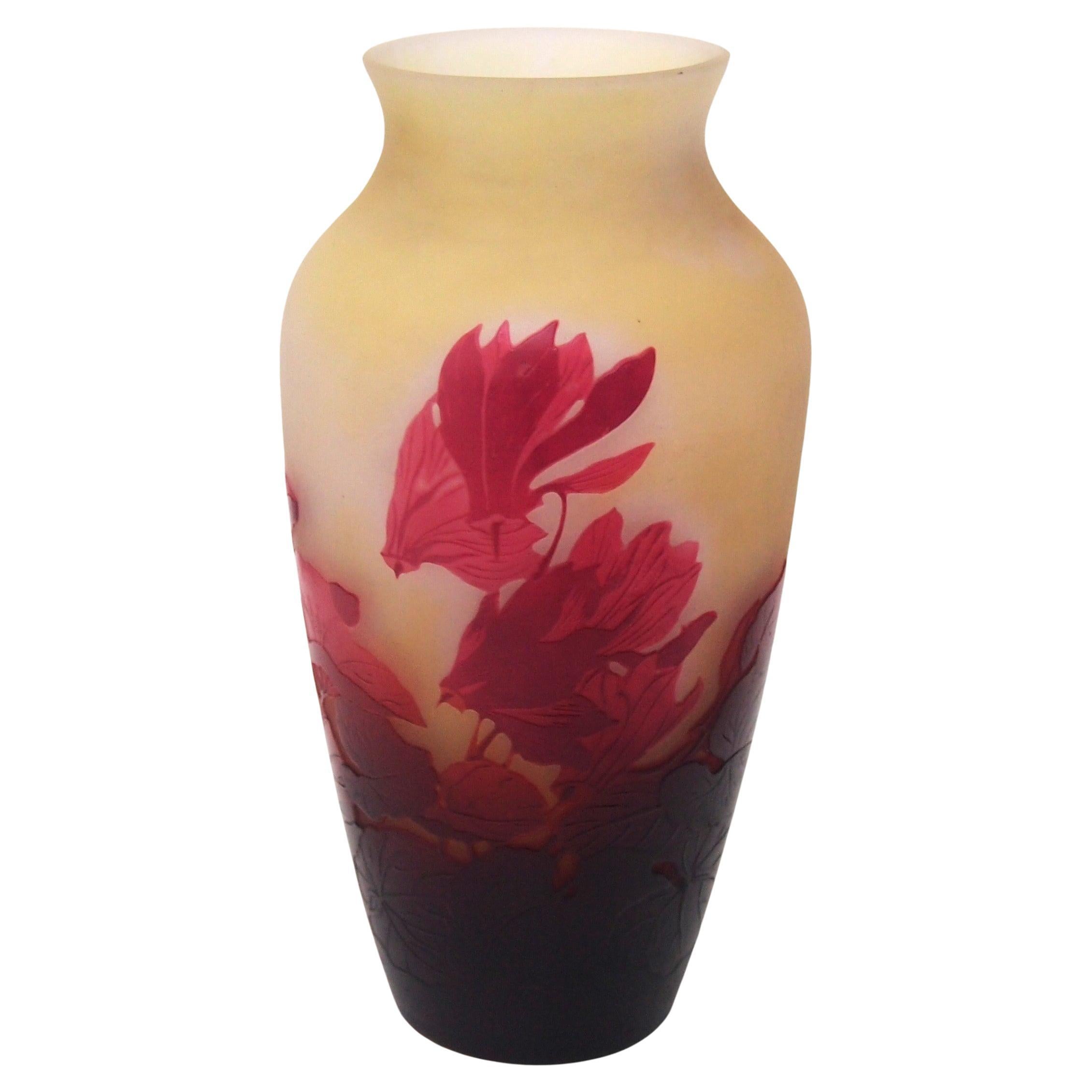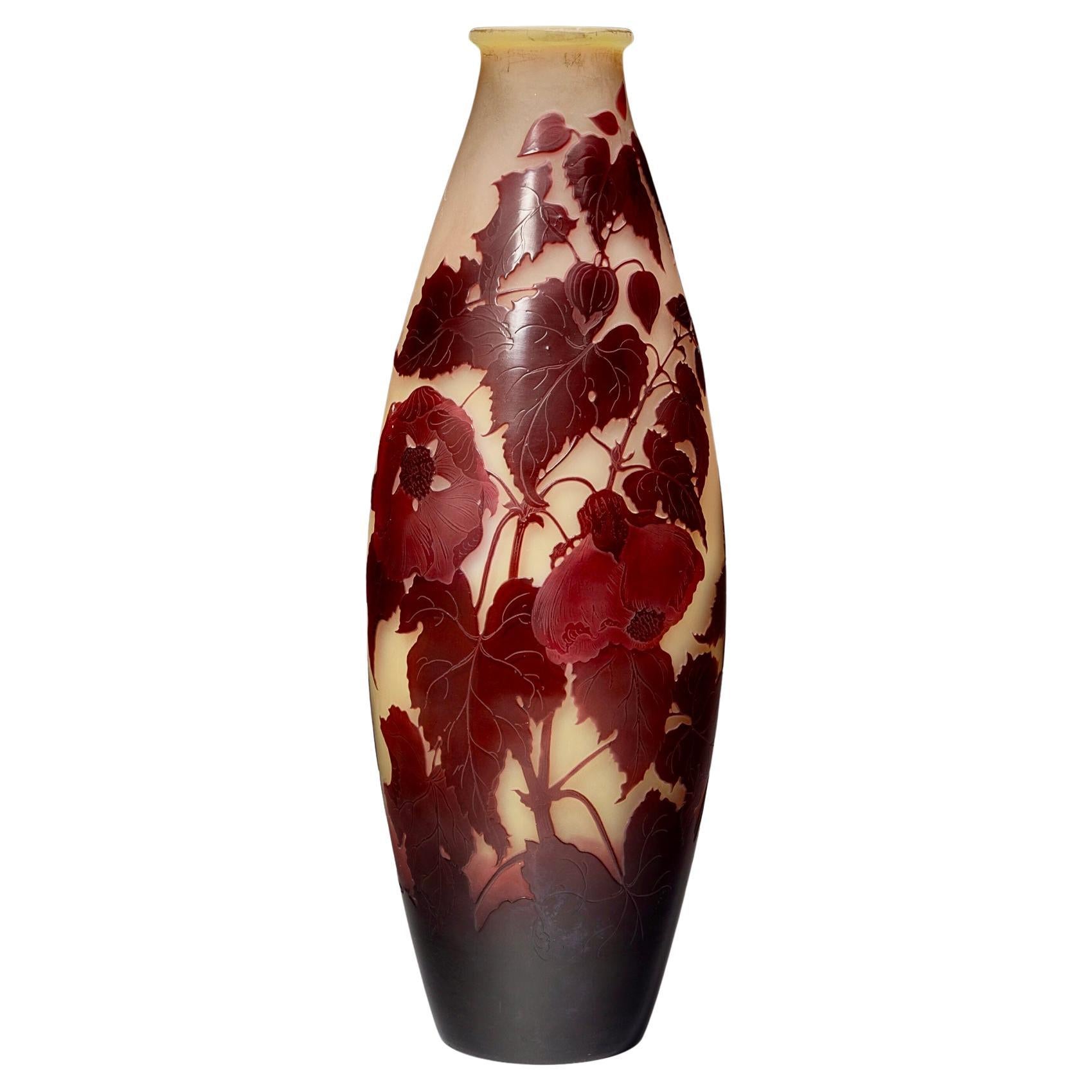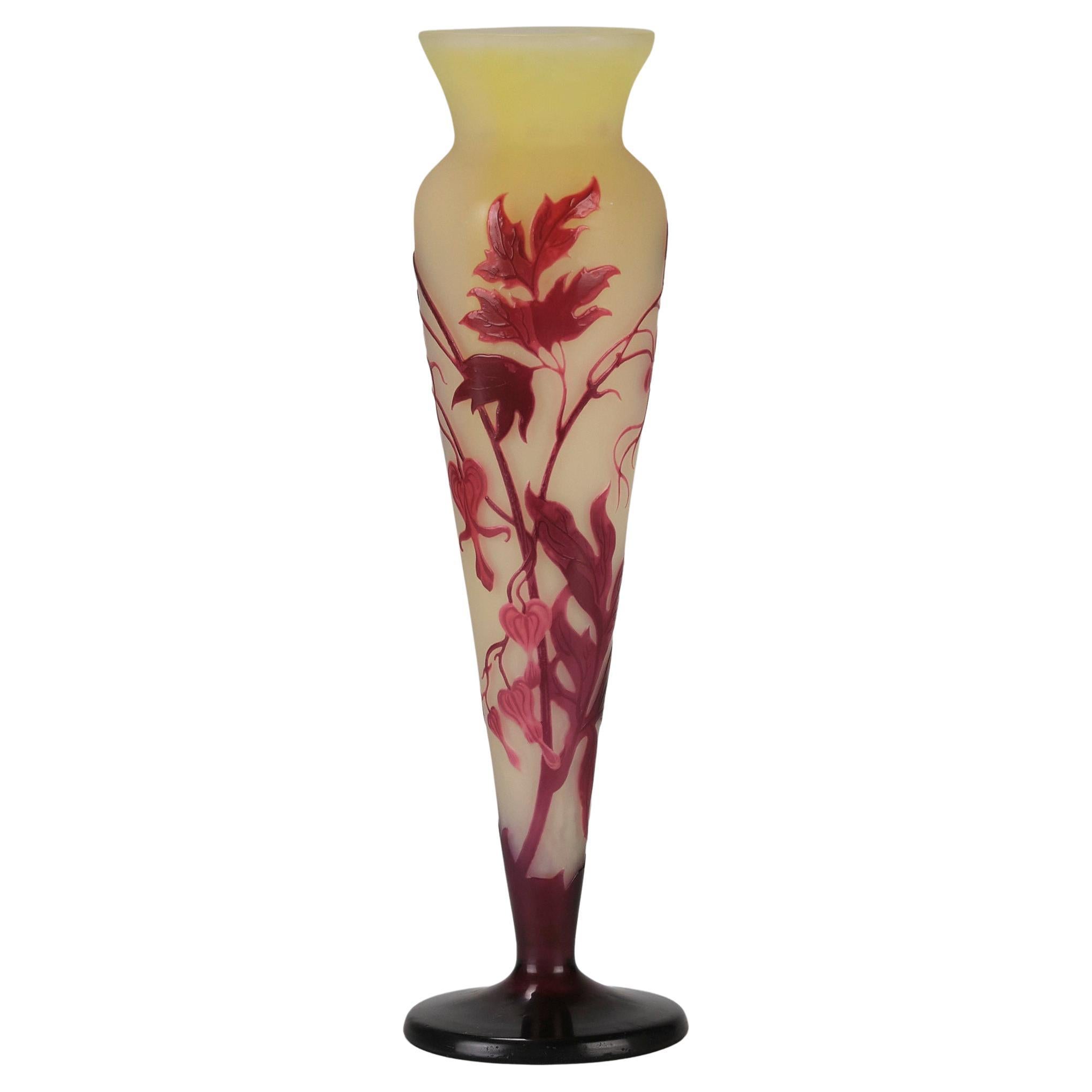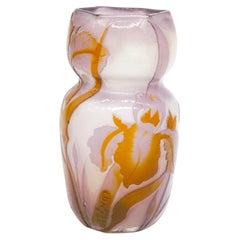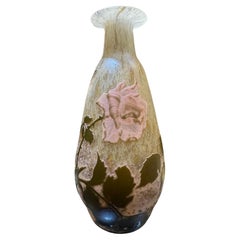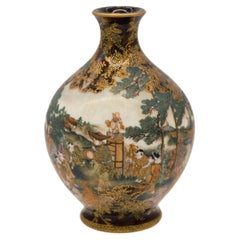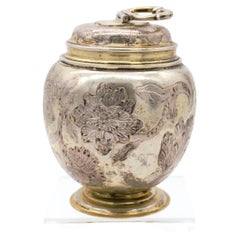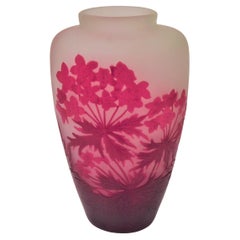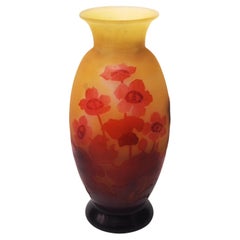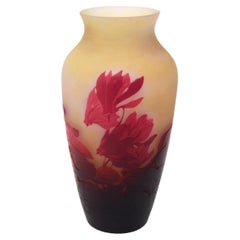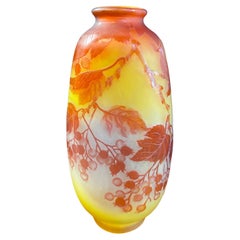Items Similar to ÉMILE GALLÉ Vase, circa 1900 overlaid cameo glass red flowers, square shape
Want more images or videos?
Request additional images or videos from the seller
1 of 6
ÉMILE GALLÉ Vase, circa 1900 overlaid cameo glass red flowers, square shape
$13,000
£9,875.62
€11,375.14
CA$18,597.81
A$20,396.86
CHF 10,519.52
MX$243,657.80
NOK 133,419.47
SEK 125,162.60
DKK 84,980.69
About the Item
An attractive late 19th Century cameo glass vase of elongated square form cut with decorative burgundy and red flowers against a warm yellow background with excellent hand finished detail and colour, signed Galle in cameo, this vase is rare because of the square shape it has in the middle part which becomes round on top and bottom, amazing design piece.
Measurements :
Height : 11.8 in. (30 cm)
Diameter : 4.7 in. (12 cm)
Condition
Perfect condition for its age, no brakes, no restorations.
Emile Gallé, 1846 – 1904 is considered a driving force behind the Art Nouveau movement and one of the most outstanding glass artists of his time. His naturalistic designs and innovative techniques greatly contributed to the development of the art of glass-making and to the Art Nouveau Style.
Emile lived during an age of technological, scientific, and political explosion. He travelled extensively in Europe and witnessed techniques that would greatly influence his work such as cameo and enamelling. He began producing fine pottery, furniture and jewellery before setting up his own glass studio in 1873 and taking over his father’s factory 4 years later.
After being inspired by the glass works at the 1878 International Exhibition in Paris, particularly cameo works, Gallé made his mark as a true artist in glass at the 1884 Union Centrale des Arts Décoratifs in Paris where he showed 300 pieces of great artistic variety as well as technical expertise. He returned to the International Exhibition in Paris in 1889 to present his own new types of glass. The pieces featured new vase shapes, extraordinary new colours, carved cameo and pate de verre work. The event was a breakthrough for him and the Art Nouveau style in general, with his pieces beginning to be widely imitated (notably by the likes of the Daum brothers.)
In 1894 Gallé built his own manufacturing plant in Nancy which throughout the 1890’s employed a team of craftsmen-designers who worked on his designs, only ever applying his signature after his approval. Demand for Gallé’s work was high so there were 300 employees working at the factory and Gallé revolutionised the Art Glass industry by mass-producing pieces using industrial techniques for the first time.
He enjoyed great success exhibiting his Art Nouveau works winning international awards and recognition through commissions and increased popular demand, and in 1901 he founded and was first president of ‘L’Ecole de Nancy’.
Gallé died in 1904 and his widow continued to run the glassworks until the war broke out in 1914. Glass sold since Gallé’s death was marked with a star after his signature and continued to be made until 1935 when the firm closed down.
Influences, Style and Technique
Emile Gallé was greatly influenced by the techniques he learnt while travelling around Europe, such as the cameo glass of great designers like Eugene Rousseau, and the enamelling used on Oriental pieces. Every piece created by his factory was heavily influenced by his passion of naturalistic designs. His pieces feature every sort of plant life, from thistles to fuchsias, clematis to chrysanthemums. Insects were also a frequent theme, with many of his pieces including butterflies, dragonflies and insects. Gallé also often decorated his pieces with landscape scenes, and was also influenced by Japanese design.
Gallé’s Cameo Glass was made with layering coloured glass, using acid to remove part of the layers and adding wheel carved detail on the better pieces. He discovered applying metallic foils between the coloured glass sheets created a stunning effect, especially when applied in the cameo work. His enamel work was just as revolutionary as he mixed metallic oxides with glass and suspended them in oil, giving the pieces a completely different finish after firing.
Gallé’s glass vessels are each unique in their own way, often containing blazes of colour, constellations of air bubbles, shimmering flecks of imbedded metal foils, and often, entrapped figures of insects that seem to float in a haze. The effects used brought his subject matter to life, and his constant adoption of new techniques and imaginative use of them in combination with his own influences and industrial innovations revolutionised the art of glass making.
His work normally signed Gallé in relief. Works made by his factory after his death.
- Dimensions:Height: 11.8 in (29.98 cm)Diameter: 4.7 in (11.94 cm)
- Materials and Techniques:
- Period:
- Date of Manufacture:1900
- Condition:
- Seller Location:Tel Aviv - Jaffa, IL
- Reference Number:1stDibs: LU8130237681152
About the Seller
No Reviews Yet
Vetted Professional Seller
Every seller passes strict standards for authenticity and reliability
1stDibs seller since 2023
- ShippingRetrieving quote...Shipping from: Tel Aviv - Jaffa, Israel
- Return Policy
Authenticity Guarantee
In the unlikely event there’s an issue with an item’s authenticity, contact us within 1 year for a full refund. DetailsMoney-Back Guarantee
If your item is not as described, is damaged in transit, or does not arrive, contact us within 7 days for a full refund. Details24-Hour Cancellation
You have a 24-hour grace period in which to reconsider your purchase, with no questions asked.Vetted Professional Sellers
Our world-class sellers must adhere to strict standards for service and quality, maintaining the integrity of our listings.Price-Match Guarantee
If you find that a seller listed the same item for a lower price elsewhere, we’ll match it.Trusted Global Delivery
Our best-in-class carrier network provides specialized shipping options worldwide, including custom delivery.More From This Seller
View AllÉMILE GALLÉ 'Iris' Vase, circa 1900 overlaid cameo and fire polished glass
By Émile Gallé
Located in Tel Aviv - Jaffa, IL
ÉMILE GALLÉ (1846-1904)
Rare and important 'Iris' Vase, circa 1900
Overlaid cameo and fire polished glass, well documented in books and exhibitions
Signed in cameo Gallé.
Measuremen...
Category
Early 20th Century French Art Nouveau Vases
Materials
Art Glass, Blown Glass, Cut Glass
Rare Daum Nancy Wheel-Carved Rose 'La France' double overlay Cameo Glass Vase
By Daum
Located in Tel Aviv - Jaffa, IL
This wonderful, elegantly shaped with a flared rim vase , by Daum Nancy, features
wheel-carved cameo glass of the highest quality detailing an amazing pink roses, or rose of France ...
Category
Vintage 1910s French Art Nouveau Vases
Materials
Art Glass, Blown Glass, Cut Glass, Opaline Glass
Satsuma earthenware vase by kinkozan, Meiji period
By Kinkozan
Located in Tel Aviv - Jaffa, IL
the body of this small marvelous vase is painted with a scene of a puppet show vendor with his wood backpack, on top of the backpack there are toys and dolls, he is surrounded with a group of 6 children, and on the background you can see a village.
on the other side of the vase there is an amazing painting of flowers and on the sides there are two amazing strong pine trees, the amorphous background is decorated in a "Tortoiseshell" color and design that gives it a real character and which is quite rare to see on satsuma pottery.
all the vase is over richly overpainted over the glaze with gold, which gives it its depth and realism.
signed Kyoto Kinkozan zo, and sealed Kinkozan zo
Kyoto’s Satsuma:
The painting technique used in Kyoto’s Satsuma-style ware is said to be the invention of the sixth generation Kinkōzan Sōbei (1824–1884). The Kinkōzan were a famous family of Kyoto Awataguchi potters who made ceramics that were used at Shōren'in, a temple closely tied to the imperial family, and by the shoguns of the Edo government. In fact the shogun is said to have granted them the name Kinkōzan. With the upheavals at the end of the Edo period, however, and the reforms of the subsequent Meiji government, the potters lost their traditional patrons and had to develop new markets.
Just at that time, the visit of a certain Westerner is said to have decided them to embark on overseas trade. By 1870, they had perfected Kyō Satsuma...
Category
Antique 1890s Japanese Meiji Ceramics
Materials
Gold
Rare German Parcel-Gilt Silver Canister, Abraham Drentwett i, Augsburg 1649-1666
Located in Tel Aviv - Jaffa, IL
Important German parcel-gilt silver canister, Abraham Drentwett I, Augsburg, circa 1649-1666 Abraham Drentwett I is one of Augsburg's foremost silversmiths during the Baroque period. He was Active 1641-1666 , he is best known for having executed Queen Christina's silver throne...
Category
Antique 17th Century German Baroque Sterling Silver
Materials
Silver
Early 20th Century Silver Spice Tower by Yehia Yemini, Bezalel School Jerusalem
Located in Tel Aviv - Jaffa, IL
Very rare Bezalel Jerusalem silver filigree spice tower, this amazing spice Tower was Made by Yehia Yemini, who was the best filigree artist in bezal...
Category
Vintage 1920s Israeli Sterling Silver
Materials
Silver
Important Rothschild family French silver presentation plate by Maurice Mayer
Located in Tel Aviv - Jaffa, IL
extremely rare french silver presentation plate/ dinner plate.
this important plate is one of the best quality work and engraving i have ever seen in my life, the outer rim is all adorned
and ornate with flowers in neoclassical style, and the actual plate is all hand engraved with the most incredible engraving with gold plating on just the engraved patterns what makes the plate looks like the gold plated part is 3 dimensional.
This important plate was made in paris by the famous silver master Maurice Mayer...
Category
Antique Late 19th Century French Neoclassical Sterling Silver
Materials
Gold Plate, Silver
You May Also Like
French Art Nouveau Red and Clear Signed Emile Gallé Cameo Glass Vase circa 1920
By Émile Gallé
Located in Worcester Park, GB
Beautiful signed French Art Nouveau Emile Gallé botanical cameo vase depicting flowers in reds over frosted clear. A good size; the oval profile vase has ...
Category
Vintage 1920s French Art Nouveau Glass
Materials
Art Glass
French Art Nouveau Signed Red Anemone Emile Gallé Cameo Glass Vase circa, 1925
By Émile Gallé
Located in Worcester Park, GB
French Art Nouveau Emile Gallé cameo vase depicting multiple Flowering Anemones in Reds over orange-yellow, with fine internal polishing to highlight the red in the flowers -A good s...
Category
Vintage 1920s French Art Nouveau Glass
Materials
Art Glass
French Art Nouveau Signed Red Cyclamen Emile Gallé Cameo Glass Vase circa 1920
By Émile Gallé
Located in Worcester Park, GB
A dramatic French Art Nouveau Emile Gallé cameo vase depicting multiple Flowering Cyclamen in reds over orange-yellow, with fine internal polishing to highlight the red in the flower...
Category
Vintage 1920s French Art Nouveau Glass
Materials
Art Glass
Emile Galle Cameo Glass Vase with red berry motif
By Émile Gallé
Located in Philadelphia, PA
Emile Galle acid-etched Cameo Glass Vase. Technique involves multiple layers of colored glass, with designs created by etching away layers. His work gained significant recognition ...
Category
Antique Late 19th Century French Art Nouveau Vases
Materials
Art Glass
Emile Galle Red Cameo Vase
By Émile Gallé
Located in Dallas, TX
Emile Gallé Art Nouveau Acid etched and cameo three color glass vase. Rose flowers are window pained and let delicate lights waves through in a translucent effect, This is a rather l...
Category
Antique Early 1900s Art Nouveau Vases
Materials
Art Glass
Early 20th Century French Cameo Glass Vase "Slender Floral Vase" by Emile Galle
By Émile Gallé
Located in London, GB
A very attractive early 20th Century French cameo glass slender shaped vase decroated with deep burgundy and red flowers against a vibrant yellow field, signed Gallé.
ADDITIONAL INF...
Category
Early 20th Century French Art Nouveau Vases
Materials
Glass
More Ways To Browse
Antique Furniture And Jewelry
19th Century Cameos
Antique Glass Squares
Flower Applique
Butterfly And Insect
Antique Glass Sheets
Etched Flower Vases
Old Jar
R Lalique Vase
Rorstrand Lonegren
Round Vase Large
Salt Glazed Vase
Sevres Porcelain Cobalt Vase
Striped Glass Vase
Studio Pottery Terracotta
Uppsala Ekeby
V Nason Murano
Vase With Cherubs
